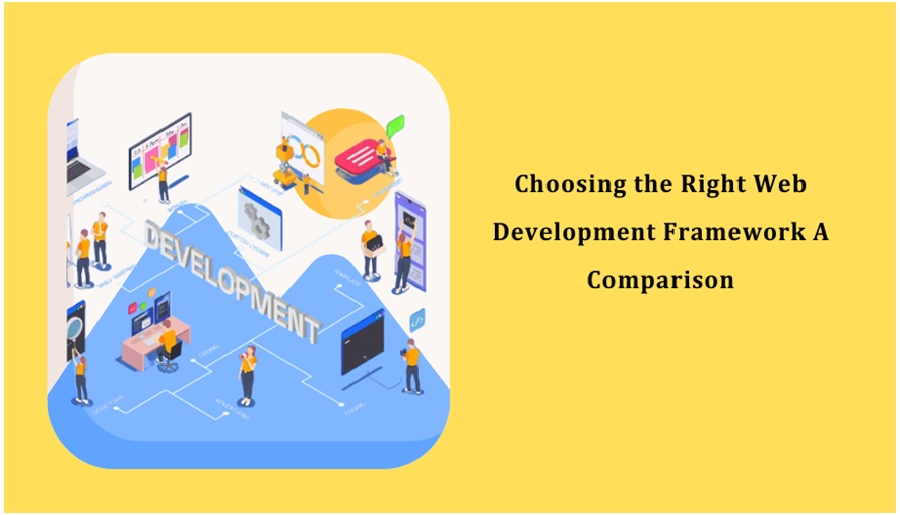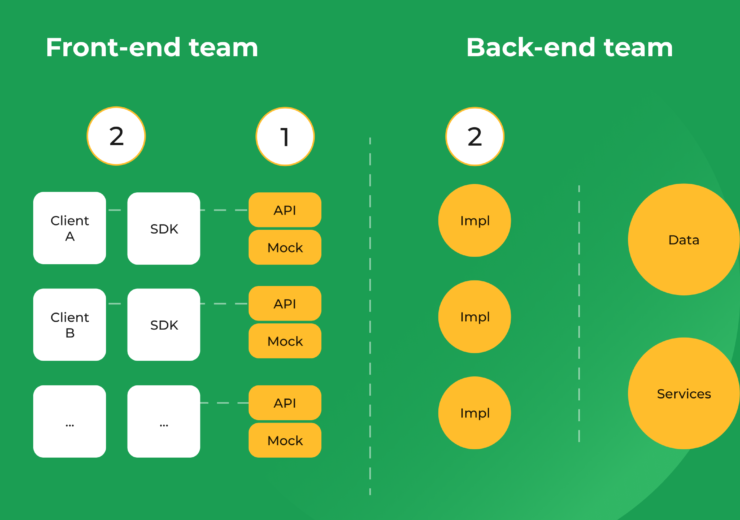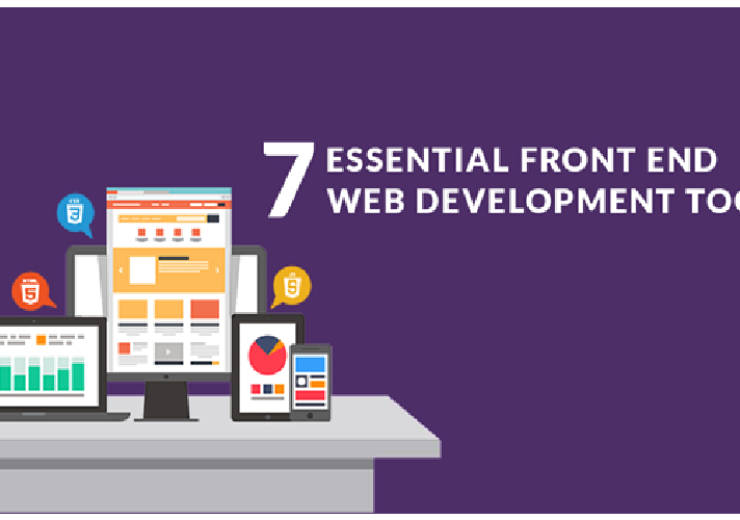Choosing the Right Web Development Framework: A Comparison of Top Options

Choosing the right web development framework can make a huge difference in the success of your project. There are many factors to consider, and the “best” choice for one project might not be the best for another.
Picking the right framework unlocks superpowers for building strong, adaptable web apps.
Key Considerations:
- Project requirements: What are the specific features and functionalities your application needs?
- Scalability: Will your application need to handle growing traffic and user demands?
- Team expertise: Does your team have experience with the chosen framework?
- Learning curve: How much time and effort will it take for your team to learn the framework?
- Community support: Is there a large and active community for the framework to provide help and answer questions?
- Security: Does the framework have built-in security features and a good track record?
- Performance: How well does the framework perform in terms of speed and efficiency?
- Existing technology stack: Does the framework integrate well with your existing tools and services?
1)Get crystal clear on your project’s goals and needs.
Building any kind of project, from a small website to a complex enterprise application, is like embarking on a journey. And just like any journey, the most crucial step before setting off is knowing your destination and purpose.
That’s where “getting crystal clear on your project’s goals and needs” comes in. It’s not just a catchy phrase; it’s the foundation on which your entire project rests.
Understanding your goals:
The Big Picture:
What is the overall objective of your project? What problem are you trying to solve or what opportunity are you trying to capitalize on?
Is it to increase brand awareness, generate leads, streamline internal processes, or create a cutting-edge new product? Defining these overarching goals will guide your every decision and keep you focused throughout the development process.
- The Measurable Milestones:
Are your goals vague aspirations or concrete targets? Setting SMART goals (Specific, Measurable, Achievable, Relevant, and Time-bound) ensures you know where you’re heading and can track your progress along the way.
For example, instead of aiming for “increased website traffic,” set a goal of “growing monthly unique visitors by 20% within the next quarter.”
Identifying your needs:
- Essential Functionality:
What features and functionalities does your project absolutely require to fulfill its purpose? Think of it as the bare minimum, the features that simply can’t be missing.
For an e-commerce platform, a shopping cart and secure payment gateway are non-negotiables.
- User Expectations:
Who are your target users, and what do they expect from your project? Considering their needs, pain points, and preferences will help you prioritize features and functionalities that add value and keep them engaged.
If you’re building a mobile app, smooth usability and intuitive navigation are key.
- Technical Constraints:
Does your project have any specific technical requirements, such as compatibility with existing systems, security protocols, or performance benchmarks?
Addressing these limitations upfront will prevent technical headaches down the line.
This detailed understanding of goals and needs guides every decision, from choosing the right web development platform to designing the user interface and marketing campaigns.
It ensures the final website is not just technically sound but also aligns perfectly with the bakery’s aspirations and customer expectations.
2) Key Factors that Influence Scalability in a Framework:
1. Architecture:
Modular Structure: Frameworks that promote code organization into independent, reusable components facilitate horizontal scaling by allowing you to distribute components across multiple servers.
Microservices Support: Frameworks that embrace microservices architecture enable you to break down applications into smaller, independently scalable services, enhancing flexibility and resilience.
2.Performance Optimization:
Caching:
Frameworks that provide built-in caching mechanisms for storing frequently accessed data in memory or faster storage can significantly improve response times and reduce database load.
Asynchronous Operations:
Frameworks that support asynchronous processing allow for handling time-consuming tasks in the background, preventing them from blocking user interactions and maintaining responsiveness.
3. Database Integration:
ORM (Object-Relational Mapper): Frameworks that include ORMs can improve database interactions and potentially simplify scaling database operations.
Database Agnostic: Frameworks that are not tied to a specific database allow for greater flexibility in choosing the most scalable database solution for your application’s needs.
4. Deployment Flexibility:
Cloud Compatibility: Frameworks that are well-suited for deployment on cloud platforms like AWS, Azure, or Google Cloud facilitate easy scaling of resources as needed.
Containerization Support: Frameworks that integrate with containerization technologies like Docker simplify the process of packaging and deploying applications across multiple servers.
5. Community and Resources:
Active Community: A large and active community can provide valuable insights, best practices, and tools for scaling applications built with a particular framework.
Extensive Documentation: Comprehensive documentation that includes guidelines for scaling applications is crucial for developers to make informed decisions.
Remember, choosing a framework with good scalability features is crucial for building web applications that can grow and adapt to meet evolving demands.
3) Team Expertise: The Engine Driving Successful Projects
In the software development realm, having the right tools isn’t enough. Just like a powerful car needs a skilled driver to reach its destination, successful projects rely heavily on team expertise.
Let’s delve deeper into this crucial factor and discover how it fuels development journeys.
it’s a multifaceted blend of:
- Technical skills: Proficiency in programming languages, frameworks, tools, and methodologies like Agile or Waterfall.
- Domain knowledge: Understanding the specific industry, target audience, and problem space of the project.
- Soft skills: Excellent communication, collaboration, critical thinking, problem-solving, and time management abilities.
- Experience: Accumulated knowledge and problem-solving approaches gained through past projects.
Why is it Important?
- Quality and Efficiency: Expert developers understand best practices, leading to clean, maintainable code and efficient development processes.
- Problem-solving Prowess: Experienced teams navigate challenges with composure and ingenuity, minimizing roadblocks and delays.
- Meeting Deadlines and Expectations: Strong expertise fosters realistic assessments and efficient workflow, ensuring timely deliveries and project success.
- Innovation and Creativity: Skilled individuals bring fresh perspectives and ideas to the table, propelling projects beyond routine solutions.
Remember, expertise is not a static state but a continuous journey. By prioritizing and nurturing it within your team, you equip yourselves with the engine and fuel needed to navigate the software development landscape with confidence and success.
Selecting the right web development framework for your project is crucial, but it’s equally important to consider the learning curve involved for your team.
How much time and effort will it take for them to become proficient in the chosen framework and deliver on project expectations? Let’s dive deeper into this aspect:
Factors Influencing the Learning Curve:
Team’s Existing Skillset
Prior experience with similar frameworks can significantly shorten the learning curve.
For example, transitioning from React to Vue.js might be easier than switching from a PHP backend to a Node.js framework.
Familiarity with the underlying programming language (e.g., JavaScript, Python, Java) also plays a role.
Framework Complexity:
Some frameworks like Django or Spring Boot have steeper learning curves due to their feature-rich nature and complex underlying architecture.
Simpler frameworks like Flask or Vue.js are generally easier to pick up, but may lack the scalability or built-in features for larger projects.
Available Resources and Documentation
Comprehensive documentation, tutorials, and code examples provided by the framework community can significantly ease the learning process.
Active online forums and communities offer troubleshooting guidance and peer support.
Learning Strategy and Support:
Dedicated training sessions, workshops, or boot camps can accelerate the learning process, especially for complex frameworks.
Mentorship from experienced developers familiar with the framework can provide valuable guidance and address specific challenges.
Tips for Minimizing the Learning Curve:
- Choose a framework aligned with your team’s skills and project needs. Don’t jump into a complex framework if a simpler one suffices.
- Utilize available resources: Leverage well-documented frameworks, online tutorials, and community support effectively.
- Invest in training and mentorship: If necessary, allocate resources for dedicated learning sessions or expert guidance.
- Practice makes perfect: Encourage hands-on experience through smaller projects or personal coding experiments.
- Foster a collaborative learning environment: Allow team members to share knowledge, learn from each other, and address challenges collectively.
Remember, the learning curve is an integral part of choosing a web development framework. By carefully assessing your team’s existing skills, the framework’s complexity, and available resources, you can make an informed decision that minimizes the learning burden and leads to successful project outcomes.
4) Community support
In the vast wilderness of web development frameworks, choosing the right one is just the first step.
The next crucial factor? Community support.
It’s the hidden oasis, teeming with resources and friendly faces, ready to guide you through challenges and propel you towards success.
Why does community support matter?
- Troubleshooting Lifeline: Stuck on a bug? Need clarification on a specific feature? A bustling community provides answers, solutions, and workarounds through forums, Q&A platforms, and online chats.
- Knowledge Reservoir: Tap into a collective wellspring of experience. Learn from seasoned developers, discover best practices, and stay updated on framework trends through tutorials, code libraries, and insightful discussions.
- Collaborative Problem-solving: No developer is an island. When facing complex challenges, the community offers a sounding board for brainstorming solutions, sharing different perspectives, and ultimately forging the best path forward.
- Confidence Booster: Knowing you’re not alone is invaluable. A supportive community provides encouragement, fosters a sense of belonging, and reminds you that every developer encounters bumps on the road.
Evaluating Community Strength:
- Size and Activity: A large and active community means more voices contributing, faster response times, and a wider range of expertise available. Look for forums with frequent posts, dedicated social media groups, and regular meetups or conferences.
- Quality of Resources: Do resources cater to all skill levels? Are tutorials well-written and up-to-date? Does the community maintain comprehensive documentation and code libraries?
- Helpfulness and Friendliness: Is the atmosphere welcoming and supportive? Are experienced developers willing to mentor newcomers and answer questions without judgment?
Examples of Strong Framework Communities:
- React: Boasts a massive and vibrant community with extensive documentation, countless tutorials, and dedicated online forums like Stack Overflow and Reactiflux.
- Django: Renowned for its welcoming “Ask Django” forum, active Slack channels, and regular DjangoCon conferences where knowledge flows freely.
- Spring Boot: The Spring community provides excellent documentation, online forums, and Spring One conferences, promoting collaboration and knowledge sharing among developers.
How to Leverage Community Support:
- Actively participate: Ask questions, share your experiences, and contribute to discussions. The more you engage, the stronger the community becomes.
- Seek help when needed: Don’t hesitate to reach out for guidance. You’ll be surprised at the wealth of knowledge and willingness to help within the community.
- Contribute back: As you gain expertise, pay it forward by answering questions, writing tutorials, or mentoring newcomers.
5) Security
- Protecting User Data: Your applications likely handle sensitive user information like passwords, financial details, or personal data. A secure framework helps safeguard this data from unauthorized access, breaches, and malicious attacks.
- Preventing Website Defacement: Vulnerabilities in your framework could let attackers hijack your website, inject malicious code, or display unwanted content, damaging your reputation and trust.
- Maintaining User Confidence: When users know their data is secure, they are more likely to trust your application and engage with it freely. Poor security can lead to lost users, financial losses, and legal repercussions.
Key elements of a secure framework:
- Built-in Security Features: Look for frameworks that offer mechanisms to prevent common vulnerabilities like SQL injection, cross-site scripting, and cross-site request forgery. Features like input validation, data encryption, and secure session management are essential.
- Community Vigilance: A proactive community promptly identifies and addresses security vulnerabilities as they arise. Regular updates and patches are crucial for maintaining robust security.
- Track Record of Security: Choose a framework with a proven history of being secure and resistant to cyberattacks. Reviews from independent security researchers and user experiences can be valuable indicators.
Tips for Choosing a Secure Framework:
- Prioritize security features: Compare built-in security features offered by different frameworks and choose one that aligns with your project’s specific needs.
- Research the community: Look for frameworks with a strong community, known for its awareness of security issues and rapid patching of vulnerabilities.
- Stay updated: Regularly check for security updates and patches released by the framework developers and apply them promptly to maintain optimal security.
- Follow best practices: Implement secure coding practices and utilize provided security mechanisms within the framework to further strengthen your application’s defenses.
Remember, security is an ongoing journey, not a one-time destination. Choosing a framework with robust security features and a vigilant community is the first step. However, it’s equally important to stay informed, update regularly, and follow secure coding practices to ensure your web applications remain fortresses against online threats.
Performance
In the digital world, speed is king. Users expect web applications to respond instantly, load seamlessly, and handle complex tasks without lagging. That’s where framework performance takes center stage.
Choosing a framework that delivers optimal speed and efficiency is crucial for creating a smooth and satisfying user experience. Let’s explore the intricacies of performance and its impact on your development journey
Why is Framework Performance Important?
- Enhanced User Experience: Faster loading times, responsive interactions, and efficient handling of user requests translate to a smoother and more enjoyable experience for your users.
- Increased Conversion Rates: Studies show that even tiny delays in page load times can significantly impact conversion rates. A performant framework helps you capture and retain users effectively.
- Improved Search Engine Optimization (SEO): Google and other search engines prioritize faster-loading websites in their rankings. A highly performant framework can give your SEO a significant boost.
- Reduced Server Costs: Efficient frameworks require fewer server resources, potentially leading to reduced hosting costs and improved scalability for your application.
Factors Influencing Framework Performance:
- Architecture: Frameworks that prioritize lightweight code, efficient memory management, and asynchronous operations tend to perform better.
- Built-in Optimization Features: Look for frameworks offering caching mechanisms, code minification, and other optimization tools to enhance speed and resource utilization.
- Community Contributions: A vibrant community that actively contributes performance-enhancing libraries and best practices can significantly improve the framework’s overall performance.
- Development Skills: Utilizing the framework’s capabilities effectively and following optimization principles within your code contribute to the final application’s performance.
Tips for Choosing a Performant Framework:
- Benchmarking and Test Runs: Consider running performance tests using tools like JMeter or LoadRunner to compare different frameworks.
- Community Insights: Look for community discussions and reviews around the framework’s performance characteristics and identify potential bottlenecks.
- Scalability: Choose a framework that can handle increasing traffic and data volume efficiently to ensure long-term performance.
- Development Expertise: Assess your team’s capabilities and choose a framework that aligns with their skillset for optimal implementation and optimization.




